-
Why Do I Keep Getting Flat Tires?
Sure, there are far worse things than a flat tire. And it’s easy to get them fixed at a nearby Les Schwab. But a tire that keeps going flat can be both irritating and dangerous. According to the National Highway Traffic Safety Administration (NHTSA), over 11,000 accidents a year are due to damaged tires. Let’s take a look at the common causes of flat tires, why some tires keep going flat, and what you can do to improve the life of your tires.
Common Causes of Flat Tires
If you’ve asked, why do my tires keep going flat, you’re not alone. Flat tires happen all the time. There’s just no way to avoid all the glass, rocks, nails, screws, curbs, and other debris dotting parking lots, roads, and highways. Here are some of the more common reasons you could get a flat tire.
Tire Age
There is no exact shelf life for a set of tires. But, as tires age, they become more susceptible to foreign objects, cracking, and more due to heat, wear, UV rays, and everyday use. As long as your tire tread is okay and you don’t find cracking, your tires may be okay.
Tire Punctures and Cuts
The more the tread on your tires is worn down, the easier your tires can be cut, gouged, or punctured. Regularly inspecting the tread on your tires can help prevent these issues. If you do get a flat, we have the tools to get it done right.
Valve Stem Problems
The simple valve stem is vitally important on today’s tires. That valve allows you to add and remove air from your tires, which helps with fuel and range efficiency, tire longevity, as well as your overall safety. If your valve stem becomes cracked, it can cause your tire pressure to drop dramatically, which could end in tire failure.
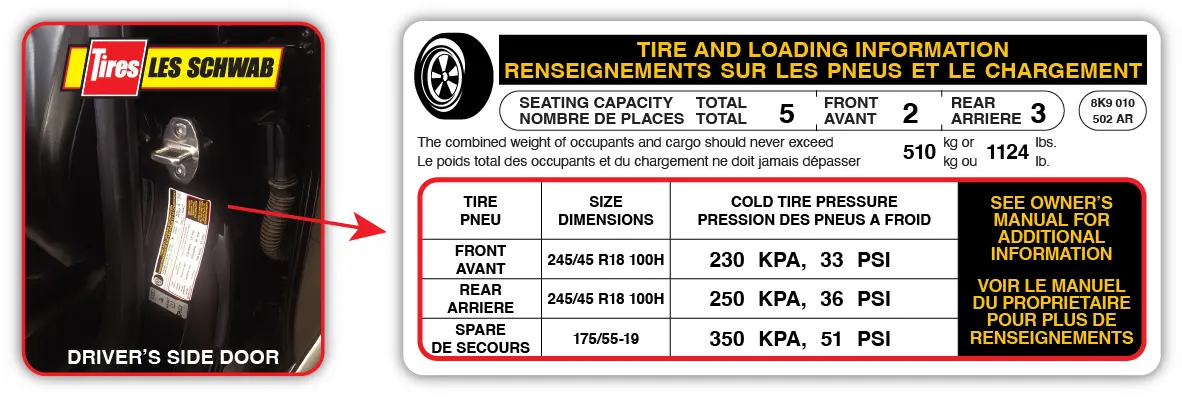
Improper Inflation
Adding air to tires is a good skill to have. Here’s how to add air to your tires. Why is proper inflation important? Because too much air can cause the rubber to separate and crack, while not enough air could affect load-carrying capacity or the rubber to break down as the sidewall bulges outward. Having the right air pressure can help your tires last longer, which will save you money. You’ll find your proper inflation levels on your driver’s side door placard (example above). Check yours once a month. Or, simply stop by Les Schwab, and we’ll top off the air for free.
Faulty Tire Pressure Monitoring System (TPMS) Sensor
The TPMS (Tire Pressure Monitoring System) sensor in each of your wheel and tire assemblies continually monitors the tire pressure in your tires. If any of them fall below 25% of the recommended air pressure, a light will appear on your dash. As with anything on a car or truck, things eventually wear down and stop working. Your TPMS sensors can eventually fail, leaving you without a warning. Or that dashboard light will appear for no reason. The next time you buy tires at Les Schwab, we’ll check your TPMS sensors and suggest replacing them if needed.
Rim Leaks
Unlike a bicycle, the tires on your car or truck do not have an inner tube. Instead, the bead seat, or the area where the tire and wheel connect, helps keep the air inside your tire. If rocks or other debris get in there, as tires age, or as rims get damaged, air can begin to leak out of the tire. This is often a slow air leak. If your tires are slowly leaking air, stop by Les Schwab. We can take a look and offer suggestions.
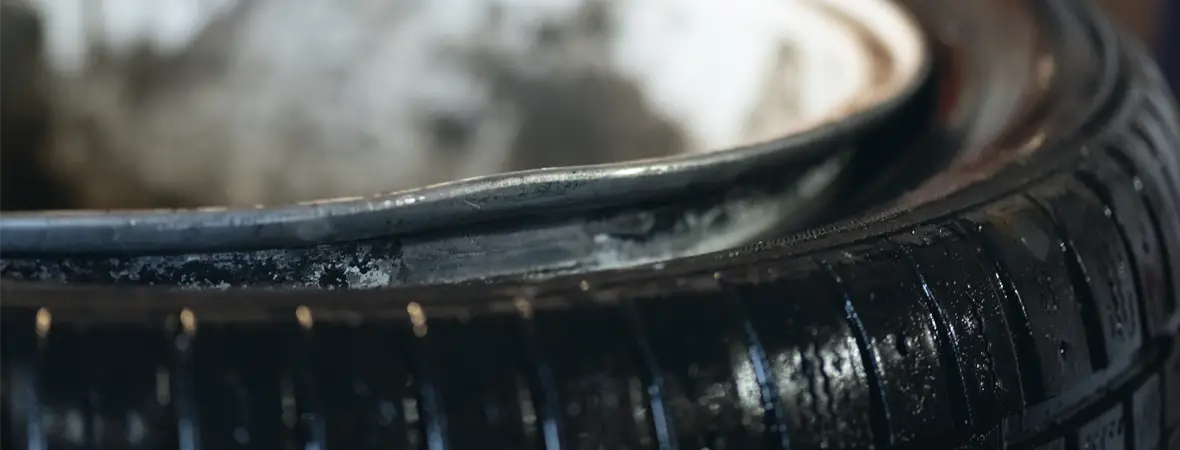
How To Prevent Flat Tires
Preventing flats starts by keeping an eye on your tires.
Regular Tire Maintenance and Rotations
After every oil change, check the tread on your tires and look for dry rot and cracks on the valve stem. Additionally, every 5,000 miles, get your tires rotated. When you have Les Schwab tires, those rotations are free and part of America’s Best Tire Warranty. Finally, stop by Les Schwab anytime for a free visual inspection of your tires.
Proper Inflation Techniques
Check and add air to your tires every month. Properly inflated tires can last longer and improve MPG and range, saving you money.
Tread Wear Inspection
The tread on your tires helps you grip the road. But that tread also helps keep glass, rocks, nails, and other debris from cutting or puncturing your tires. A quick tread inspection can help you avoid that issue. All you need is a penny and a few minutes to check the tread on your tires.
Avoiding Potholes and Road Debris
Potholes can cause bent wheel rims, internal tire damage, alignment problems, and shock and strut issues. All of those can lead to tire damage or uneven wear. Schedule an appointment at Les Schwab for a free visual inspection.
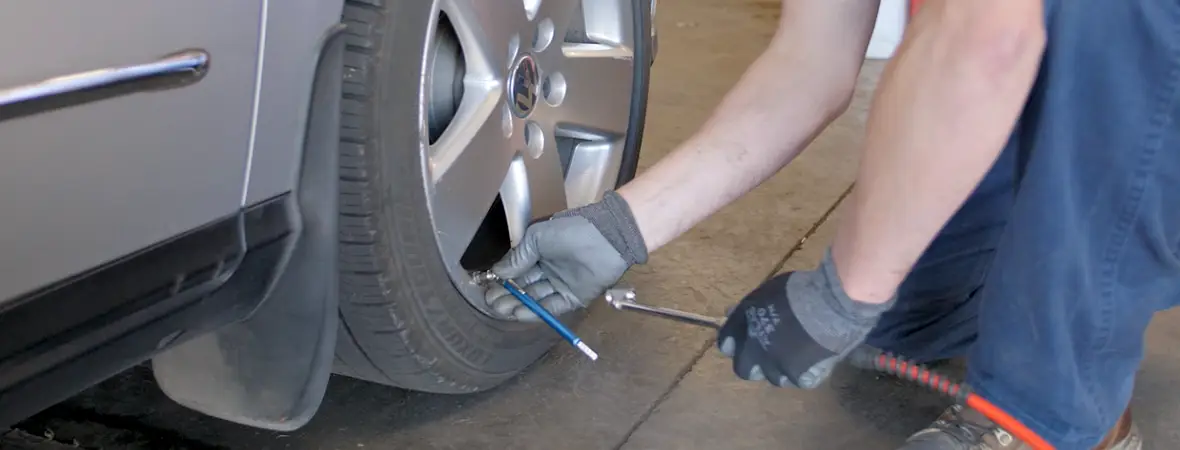
When To Seek Professional Help
At Les Schwab, we fix millions of flat tires every year. Stop by when you experience any of the following.
Slow Leaks
Tires lose air pressure over time, but a slow leak can speed that up. Check your tire pressure every month. Go to your local Les Schwab and we’ll check your tire pressure for free.
Choosing the Right Tire
Tires that fit your vehicle and your lifestyle are important. The professionals at Les Schwab can show you all of your options, from highway tires to off-road options.
Tire Replacement
The tread on your tires will eventually wear down enough that you’ll need to replace them. When that happens, drive to your local Les Schwab. We’ll ensure you get the right tires for what and where you drive, along with America’s Best Tire Warranty.
Les Schwab Is Home to America’s Best Tire Warranty
The tires you buy at Les Schwab come with America’s Best Tire Warranty. That includes our 60-day satisfaction guarantee, no-hassle road hazard protection, as well as free tire maintenance and flat repairs.
Book Your Appointment Book Your Appointment -
How to: Make Your Tires Last Longer
Do you like plunking down your hard-earned money on a new set of tires? Unless you’re a true enthusiast, probably not. If you want to extend the life of your tires, improve your car’s ride, and have a safer drive, follow these four quick tips.
1. Check Your Tire Air Pressure Monthly
Take the easiest step to extend tire life: Maintain the correct air pressure. The wrong air pressure can cause sluggish handling, increase stopping distance, increase wear and tear and heighten the risk of a blowout. Tire pressure changes:
- Every month. Tires can lose about a pound per square inch (PSI) of pressure monthly.
- In winter, when colder temperatures can lower air pressure.
- In summer, when warm weather increases tire air pressure.
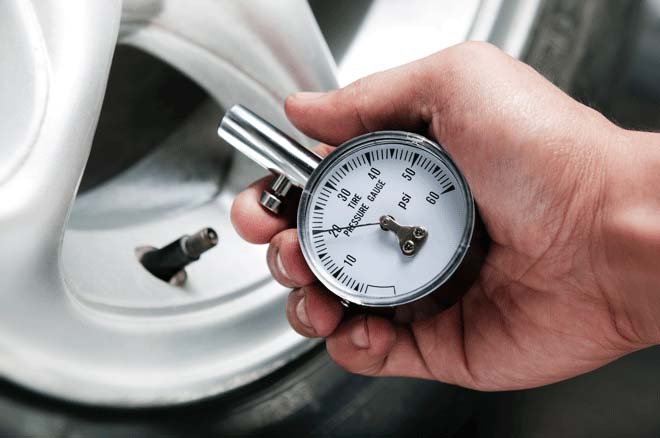
Check tire pressure monthly This isn’t just about money, either. Proper tire pressure is important for safety. A National Highway Transportation Safety Administration Crash Causation Survey found tire issues in one out of 11 crashes. (Source: http://www-nrd.nhtsa.dot.gov/Pubs/811617.pdf [PDF]) Correct air pressure improves fuel efficiency. Underinflated tires mean you’re getting fewer miles to the gallon and paying more for gas than you need to. You can improve your gas mileage by up to 3.3 percent by keeping your tires inflated to the proper pressure. (See more gas mileage tips at http://www.fueleconomy.gov/feg/drive.shtml.) The right tire pressure is an easy "win." Go check!
2. Get Your Tires Rotated Every 5,000 Miles
In most cars, only one or two wheels “drive” the car at a time. That can cause uneven tire wear. For example, on front-wheel drive vehicles, front tires wear faster. On rear-wheel drive vehicles, it’s the back tires. Even all-wheel drive vehicles can see uneven wear, as most shift the drive from one wheel to another. A technician rotates your tires by moving them to different wheel positions on the vehicle. That gives tires on drive wheels a rest and evens out wear. Rotation makes tires last longer. Do it every 5,000 miles.
3. Have Wheels Balanced
Tire rotation is a great time to get your wheels balanced, as well. Every tire and wheel has a heavy spot in it. None is perfect, even when brand new. The difference is tiny, measured in one-quarter to one-half ounces. But that small difference can cause vibration and uneven tire wear. Your mechanic can balance each wheel using a specialized machine and small weights. As the tire wears, he may need to move or change that weight. It’s a fast, easy process that costs a lot less than a new tire! Make sure you get your tires’ balance checked and adjusted during rotation.
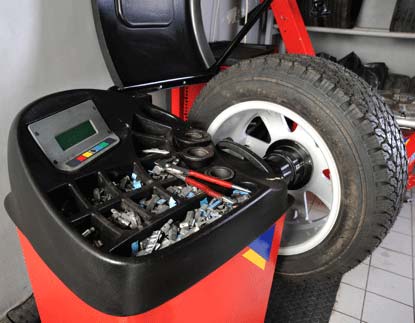
Get wheels balanced
4. Check Your Alignment Twice a Year
Misalignment may make your tires toed-in (“pigeon-toed”) or toed-out (“duck-footed”).
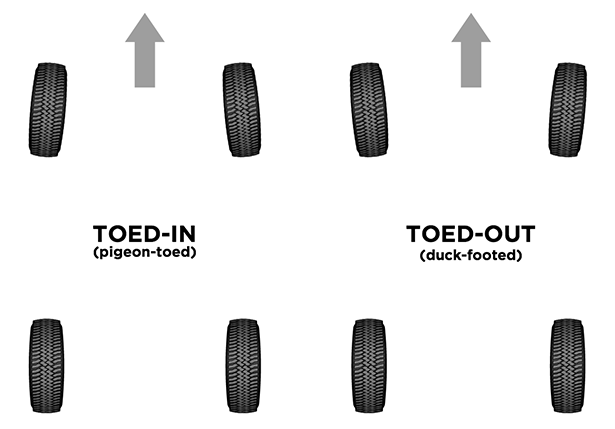
Toed-in and toed-out misalignment If your car actively pulls or drifts right or left, or the steering wheel vibrates or shakes, your car may have an alignment problem. But your car or truck could be driving fine and still be out of alignment. When you bump up against a parking lot barrier, hit a pothole, or hit the curb, something has to give, and it’s often your alignment. The smallest misalignment can reduce fuel efficiency, and increase tread wear. Your mechanic can adjust your car’s alignment. Take your car in for a check every six months. Or whenever you think something is wrong. A little maintenance can help save a lot of money. Follow these easy, inexpensive tire maintenance tips and you can increase tire life. You’ll also improve gas mileage, extend the life of your car, and make your drive a safer one. You can start right now: Check your tire pressure. See? That wasn’t hard, and you just saved yourself some money.
-
How to Put Air in Your Tires
When you have the correct air pressure in your tires, it can improve fuel efficiency and safety. According to the National Highway Traffic Safety Administration (NHTSA), under-inflated tires can reduce your MPG (Mile Per Gallon) as well as affect handling, stopping, and impact-crash avoidance systems. To avoid these issues and keep your tires properly inflated, stop by Les Schwab for a free monthly air check. Schedule your appointment now.
How Do You Know How Much Air to Put in Your Tires
First, the correct pressure or PSI (Pounds Per Square Inch) of air inside your tires is not printed on the side of the tire. That is the maximum (cold) pressure that should not be exceeded, which can be very different from your vehicle’s recommended tire pressure.
The recommended tire pressure for your vehicle (and spare tire) is located in your owner’s manual or on the driver’s side door sticker. In many cases, it will list the pressure for both the front and back wheels when cold (first thing in the morning or before the vehicle has been driven).
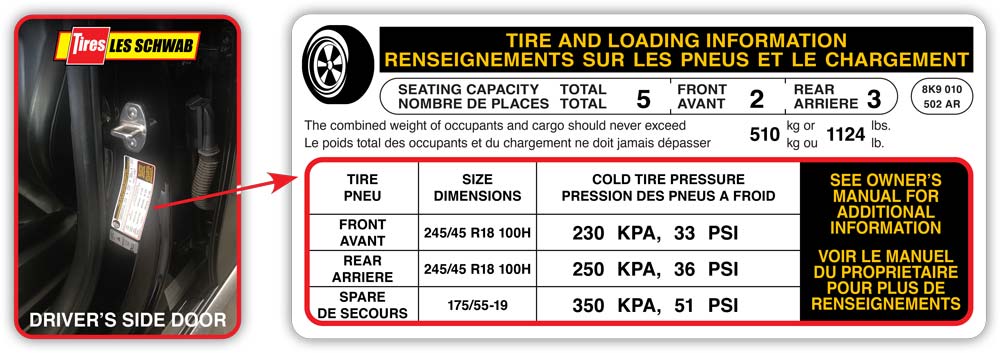
How to Put Air in Your Tires
Whether you’re at home or at the gas station, adding air to your tires can be quick and easy. Look for an air compressor at your local gas station just beyond the pump lanes. It may require a few quarters to run. At home, you’ll need an air compressor. In both cases, you’ll need a tire pressure gauge.
Check your tire pressure. It’s important to complete this step in the morning or when the tires are cold. This will give you an accurate reading. To check the pressure in each tire, use a tire pressure gauge. These often look like a metallic pencil with a sliding measuring device on one end and a tire valve connection on the other.

- Park your car in the right place. Whether you’re at a gas station or home, be sure you can safely reach all four tires with the air hose.
- Remove the tire valve cap. Put the cap in your pocket so you don’t lose it.
- Place the compressor fitting firmly on the tire valve stem. Then begin to inflate your tire. You’ll hear air going into the tire. If you hear or feel air coming out, readjust the connection between the air nozzle and the valve stem on the tire.
- Add air for a few seconds. Keep in mind that not all air compressors inflate at the same rate. You’ll want to inflate and check your tire pressure often. Add air as needed. To remove air, quickly push in the center pin located inside your tire valve.
- Replace the valve cap. This helps keep more air in your tires for a longer period of time, and can keep road debris (dirt and more) from getting into the valve.
Les Schwab Tip: If you don’t have access to an air compressor or you’re not near a gas station, a bicycle pump might work in an emergency. Just be warned, it will take a lot of pumping and could ruin the bicycle pump.
Check Your Tire Pressure Monthly
Your tires can lose one pound of pressure per month on average. Over time, those small reductions in pressure can really add up. Anytime you’re out and about, pull into your local Les Schwab and we’ll check and inflate your tires for free.
Can You Drive on a Tire with Low Air?
The short answer is, sometimes. For example, releasing some pressure out of your tires can give you more grip in deep snow. However, driving with low air pressure isn’t encouraged and could cause irreparable damage to the tires or even failure.
What happens if you get a flat and can’t immediately fill your tires with air? That’s when it’s a good idea to change to your spare and get to Les Schwab as soon as possible. If you drive a vehicle with run-flat tires, they are designed to give you some time to get to Les Schwab if you get a flat or experience a slight reduction in air pressure.
Let Les Schwab Put Air in Your Tires
Pull into any Les Schwab location and our pros will perform a free air check and inflate your tires to the proper pressure. It’s just one of the many safety-minded services we’re proud to offer you and your family.
Opens warranty information dialog with language options
